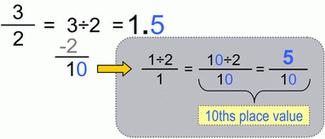













25
so for "a)" we need to round it to tenths! if we're going to turn fractions to decimals...
what are decimals??
~Quick lesson~
Decimals are always over one..
eg. _ /1
one is your denominator
~~~~~~~
so, lets start^^
if 25 is our denominator, how much do we have to divide it by to get one? ... you know the answer....
so divide 25 by 25 and you'll get 1. and what ever you do to the bottom you'll have to do it to the top. 13 divided by 25 is 0.5200 (what it says on my calculator)
round 0.5200 by tenths = o.5
so our answer is 0.5/1
Lets do the rest now! :D
b) 107/215 . 215 divided by 215 = 1 . 107 divided by 215 = 0.4976 (like how it says on the calculator again) 0.4976 round it off by hundredths = 0.50 . our answer is 0.50/1
c) 43/50 . 50 divided by 50 = 1. 43 divided by 50 = 0.860. 0.860 round it by tenths = 0.9
so our answer is 0.9/1
d) 197/289 . 289 divided by 289 = 1 . 197 divided by 289 = 0.6817. 0.6817 round it by thousandths = o.680. so our answer is o.680/1
Hope you learned at least something :)
sorry i didnt put a picture or anything. im really tired -____-'' LOL


 If your still having trouble with math questions like these, click this LINK!
If your still having trouble with math questions like these, click this LINK! If You Still Don't Understand Check out this Website! there is some questions and answers too!
If You Still Don't Understand Check out this Website! there is some questions and answers too!Converting Fractions decimals and Percent
Fractions
whole number
over over
whole numer
Eg. 1/2, 3/4/, 5/3
Decimals
Anything
over
1
EG 0.1/1, 0.5/1, 0.375/1
Percents
Percent is out of 100%
9/10 = 90%
Converting means changing fractions to decimals
2/3 = 0.75/1
0.75 is a terminating number
0.66 = repeated decimal, 0.6666666666666666666666666666 never ends


